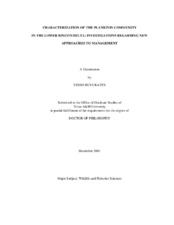| dc.contributor.advisor | Roelke, Daniel L. | |
| dc.creator | Buyukates, Yesim | |
| dc.date.accessioned | 2005-02-17T20:58:44Z | |
| dc.date.available | 2005-02-17T20:58:44Z | |
| dc.date.created | 2003-12 | |
| dc.date.issued | 2005-02-17 | |
| dc.identifier.uri | https://hdl.handle.net/1969.1/1312 | |
| dc.description.abstract | In light of increasing harmful algal blooms and the need to protect human health and aquatic resources, proactive management approaches merit further study. For this purpose I conducted field samplings to characterize plankton community composition and laboratory experiments to test some approaches to new management schemes in the lower Rincon Delta. On site measurements and microscopic analysis showed that environmental parameters and plankton community composition varied considerably among sampling stations and sampling dates. A recent modeling study suggested that manipulation of freshwater inflow to estuaries might prevent phytoplankton blooms and enhance secondary productivity. To test this theory I conducted three semi-continuous design and flow-through incubation design experiments using natural plankton assemblages. I investigated the effect of two different pulsing regimes of inflow and nutrient loading on zooplankton densities, and phytoplankton biomass and diversity. Despite differences in zooplankton structure and phytoplankton community composition between the two experiment designs, the results confirmed that pulsed inflows might alter plankton dynamics. My findings showed that 3-day pulse treatments consistently supported greater zooplankton densities and higher phytoplankton species diversity when compared to 1-day pulse treatments. In addition, accumulation of phytoplankton biovolume remained low during 3-day pulse treatments. Differences in zooplankton performance between 3-day pulse and 1-day pulse inflow treatments were likely due to the ability of phytoplankton to uptake and store greater amounts of nutrients under conditions of 3-day pulse inflow. This resulted in food of higher quality for zooplankton, and might have supported greater zooplankton population growth rates. Additionally, in an attempt to understand the mechanisms leading to high biodiversity in aquatic ecosystems, I built a resource-storage model and studied the effects of resource-storage on competition of multiple phytoplankton species on multiple abiotic resources. I compared this model with a well-established multi-species competition model. My results showed that for certain species combinations a resource-storage-based model can generate dissimilar outcomes when compared to a model without resource-storage. | en |
| dc.format.extent | 1238855 bytes | en |
| dc.format.medium | electronic | en |
| dc.format.mimetype | application/pdf | |
| dc.language.iso | en_US | |
| dc.publisher | Texas A&M University | |
| dc.subject | Rincon Delta | en |
| dc.subject | Pulsed inflows | en |
| dc.subject | Zooplankton demographics | en |
| dc.subject | Phytoplankton biomass | en |
| dc.subject | Phytoplankton diversity | en |
| dc.subject | Semi-continuous design | en |
| dc.subject | Flow-through incubation design | en |
| dc.subject | Resource management in aquatic systems | en |
| dc.subject | Multi-species competition | en |
| dc.subject | Monod model | en |
| dc.subject | Droop model | en |
| dc.subject | Competitive exclusion theory | en |
| dc.subject | Paradox of the plankton | en |
| dc.subject | Stable co-existence | en |
| dc.subject | Storage base competition model | en |
| dc.subject | heteroclinic cycles | en |
| dc.subject | Divergence of nearby trajectories | en |
| dc.subject | Complex behavior of dynamic systems | en |
| dc.title | Characterization of the plankton community in the lower Rincon Delta: Investigations regarding new approaches to management | en |
| dc.type | Book | en |
| dc.type | Thesis | en |
| thesis.degree.department | Wildlife and Fisheries Sciences | en |
| thesis.degree.discipline | Wildlife and Fisheries Sciences | en |
| thesis.degree.grantor | Texas A&M University | en |
| thesis.degree.name | Doctor of Philosophy | en |
| thesis.degree.level | Doctoral | en |
| dc.contributor.committeeMember | Pinckney, James L. | |
| dc.contributor.committeeMember | Winemiller, Kirk O. | |
| dc.contributor.committeeMember | Grant, William E. | |
| dc.type.genre | Electronic Dissertation | en |
| dc.type.material | text | en |
| dc.format.digitalOrigin | born digital | en |


